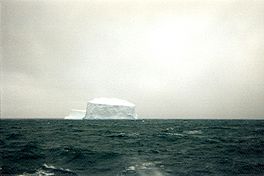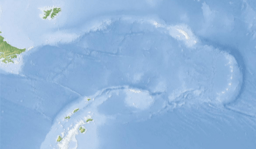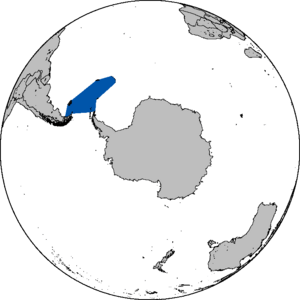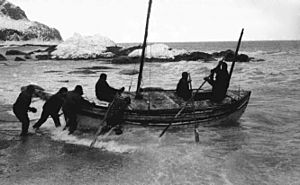Scotia Sea facts for kids
Quick facts for kids Scotia Sea |
|
|---|---|

Tabular iceberg in the Scotia Sea, 1996
|
|
 |
|
| Coordinates | 57°30′S 40°00′W / 57.500°S 40.000°W |
| Type | Sea |
| Ocean/sea sources | Southern Ocean |
| Surface area | 900,000 km2 (347,500 sq mi) |
| Max. depth | 6,022 m (19,757 ft) |


The Scotia Sea is a large body of water. It is found partly in the chilly Southern Ocean and mostly in the South Atlantic Ocean. This sea is known for its cold temperatures and often stormy weather.
Contents
Where is the Scotia Sea?
The Scotia Sea is located between several land areas. These include Tierra del Fuego, South Georgia, the South Sandwich Islands, the South Orkney Islands, and the Antarctic Peninsula. To its west, it meets the Drake Passage.
All these islands sit on top of an underwater mountain range called the Scotia Ridge. The Scotia Sea covers a huge area, about 900,000 square kilometers (347,000 square miles). About half of this sea is over a shallow part of the ocean floor called the continental shelf. The islands in this area are rocky and stay partly covered in ice and snow all year.
Amazing Animals and Plants of the Scotia Sea
The islands around the Scotia Sea are home to special plants and animals. This area is known as the Scotia Sea Islands tundra ecoregion. Tundra is a type of land where the ground is often frozen, and only small plants can grow.
These islands include South Georgia, the volcanic South Sandwich Islands, and the South Orkneys. Also, the South Shetland Islands near the Antarctic Peninsula and the small, isolated Bouvet Island are part of this region. All these islands are in the cold waters south of the Antarctic convergence.
Plants of the Scotia Sea Islands
The plants here are mostly small and tough. You can find mosses, lichen, and algae growing on the rocky, icy land. These plants are adapted to the cold and harsh conditions.
Birds of the Scotia Sea
Many seabirds, penguins, and seals live and feed in the waters around these islands.
Seabirds include four types of albatross:
- Black-browed Albatross (Diomedea melanophris)
- Grey-headed Albatross (Thalassarche chrysostoma)
- Light-mantled Albatross (Phoebetria palpebrata)
- Wandering Albatross (Diomedea exulans)
Only five types of birds stay on the land itself. Two of these are found nowhere else in the world (they are endemic):
- A type of Yellow-billed Pintail duck (Anas georgica)
- The South Georgia Pipit (Anthus antarcticus)
Penguins of the Scotia Sea
The Scotia Sea is a great place to see many different Penguin species. Large numbers of King Penguins live here. Other types include:
- Chinstrap Penguins
- Macaroni Penguins
- Gentoo Penguins
- Adelie Penguins
- Rockhopper Penguin (Eudyptes chrysocome)
Seals of the Scotia Sea
Many types of seals also call the Scotia Sea home. You can find large groups of:
- Antarctic Fur Seal (Arctocephalus gazella)
- Sub-Antarctic Fur Seal (Arctocephalus tropicalis)
Other seals in the area include:
- Leopard Seal (Hydrurga leptonyx)
- Weddell Seal (Leptonychotes weddellii)
- The huge Southern Elephant Seal (Mirounga leonina)
- Crabeater Seal (Lobodon carcinophagus)
Protecting the Wildlife
To protect these amazing animals and plants, South Georgia, the South Sandwich Islands, and Bouvet Island are set aside as nature reserves. Bird Island, South Georgia is also a special area for scientific study.
See also
 In Spanish: Mar del Scotia para niños
In Spanish: Mar del Scotia para niños


